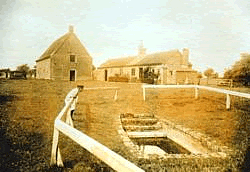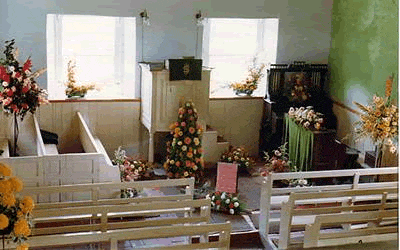
The present chapel at Monksthorpe was built in 1701. It stands in two acres of grounds, entirely surrounded by a good variety of trees. It was built like a barn with a thatched roof, so that it would not easily be recognised as a chapel. The thatched roof has long since gone, and the roof is now tiled.
Close by the chapel were stables and a caretaker’s cottage. In the grounds is an open-air baptistery with steps down into it, and it had a railing around it.
We have been much abused as we pass in the streets, and as we sit in our houses, being threatened to be hanged if heard praying to our Lord in our own families, and disturbed in our so waiting upon Him by uncivil beating at our doors, and sounding of horns, yea, we have been stoned when going to our own meetings, the windows of the place where we have met have been struck down with stones, yea, we have been taken as evildoers and imprisoned, when peaceably met together to worship the most High God, in the use of His most precious Ordinances.
So runs a petition presented to King Charles II on July 26th 1660 by 35 Lincolnshire Baptists. Nine of them lived in the parishes of Burgh and Croft. The congregation at Burgh had then been in existence for 50 or more years. In spite of the petition, worship for the Burgh Baptists continued to prove difficult. In 1665, the Five Mile Act forced the congregation to leave its place of worship in Burgh. Instead, they met in the fields in an area known as Monksthorpe.
One of those who worshipped there was Robert Shalder of Croft. He was imprisoned for nonconformity in Charles II’s reign, and he died soon after release. ‘On the day he was interred,’ wrote William White in his History and Directory of Lincolnshire, ‘so vindictive was the persecuting spirit of the conformists that it is said they took his body from the grave and dragged it upon a sledge to his own gates’.
Within the chapel is a trap door above and behind the pulpit. When it was thought that soldiers were in the area, a boy was posted outside during worship to sound the alarm, so that the preacher could shin up a ladder from the pulpit to the trap door and thus escape. Eventually, the believers were able to worship again in Burgh. Over the years the work prospered so that, under the pastorate of B.J. Bull, described as a Calvinist, the membership grew to 134 in 1842, with worshippers coming from a 12 mile radius around Burgh.
However, in the late 19th century there was a rapid decline in membership and early in the present century there was no worship for two winters. The membership was only seven in 1909 when the energetic Mr. John Dowse, then aged 72, came and re-established the cause.
In post-war years, the chapel at Monksthorpe has been used less and less, partly because it has been falling into disrepair and partly because, with only two farms at Monksthorpe, a true ‘local’ church is not possible.
At Burgh the Baptists continue to worship in the chapel on the Causeway.

Photogragh of Monksthorpe Flower Festival was contributed by Mrs Spence who created the flower festival display positioned just in front of the pulpit.
Due to the involvement of the East Midlands Baptist Association and particularly the faithful work of Bryan and Janet Keyworth together with Harry and Frances Godden, the chapel at Monksthorpe has survived. It has been repaired and restored. The ‘Friends of Monksthorpe’ have given so much to ensure the building was stabilised and rotten timber replaced.
During 1999 the building was taken over by the National Trust and further restoration is in hand. There are services at Monksthorpe 4 or 5 times a year. These are usually held on a Saturday.
 .
.